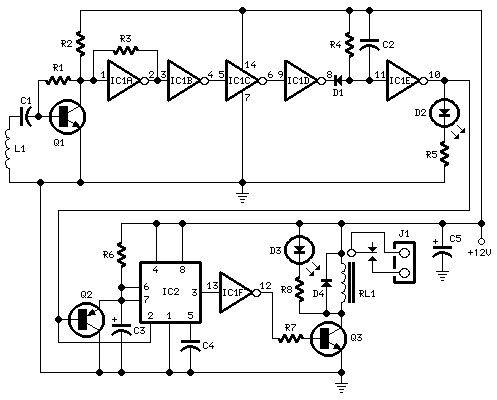Drives a relay when an incoming call is detected
12V dc supply
Circuit diagram:
Parts:
R1,R3,R4,R6______1M 1/4W Resistors
R2_______________3K9 1/4W Resistor
R5,R8____________1K 1/4W Resistors (Optional: see Text)
R7______________10K 1/4W Resistor
C1_____________100nF 63V Polyester or Ceramic Capacitor
C2_______________1µF 63V Polyester or Electrolytic Capacitor
C3______________10µF 25V Electrolytic Capacitor
C4______________10nF 63V Polyester or Ceramic Capacitor
C5_____________470µF 25V Electrolytic Capacitor
D1,D4_________1N4148 75V 150mA Diodes
D2,D3___________LEDs 3 or 5mm. (Optional: see Text)
Q1_____________BC547 45V 100mA NPN Transistor
Q2_____________BC557 45V 100mA PNP Transistor
Q3_____________BC337 45V 800mA NPN Transistor
IC1_____________4069 Hex Inverter IC
IC2_____________7555 or TS555CN CMos Timer IC
L1______________10mH miniature inductor
RL1____________Relay with SPDT or DPDT switch
Coil Voltage 12V. Coil resistance 200-300 Ohm
J1_____________Two ways output socket
Comments:
This design is a development of the well known Cellular Phone calling Detector  circuit. Many correspondents required a circuit of this kind but capable of driving a relay and supplied at 12V.
circuit. Many correspondents required a circuit of this kind but capable of driving a relay and supplied at 12V.
The final circuit adds to the original pulse detector coil and transistor amplifier a further amplifier and squarer, a pulse to dc converter, a timer and the relay driver.
The timer was necessary to avoid false triggering: in this way the relay will be energized only after the cell-phone is ringing since at least 10 seconds.
The final circuit adds to the original pulse detector coil and transistor amplifier a further amplifier and squarer, a pulse to dc converter, a timer and the relay driver.
The timer was necessary to avoid false triggering: in this way the relay will be energized only after the cell-phone is ringing since at least 10 seconds.
Circuit operation
Q1 amplifies the signal generated by the cell-phone during an
incoming call and detected by L1. IC1A wired as an analog amplifier
drives three inverters in series (IC1B, IC1C and IC1D) acting as square
wave converters. IC1E and related components form the pulse to dc
converter: when a train of pulses appears at IC1D output, a 12V steady
positive voltage is present at the output of IC1E.
An optional LED (D2) can be useful to signal that a call is incoming, mainly when the cell-phone is muted.
An optional LED (D2) can be useful to signal that a call is incoming, mainly when the cell-phone is muted.
Q2, IC2 and related components form a 10-seconds timer followed by the relay driver (IC1F and Q3).
When the output of IC1E is low, the output of IC2 is high: therefore the output of the inverter IC1F is low and Q3 is cut off.
When the output of IC1E is high, C3 starts charging through R6 and after about 10 seconds IC2 will be triggered and its output voltage will fall to zero, forcing the output of IC1F to go high: this causes the transistor to conduct and the relay will be energized.
The LED D3 is optional and can be useful to signal when the relay is on.
When the output of IC1E is low, the output of IC2 is high: therefore the output of the inverter IC1F is low and Q3 is cut off.
When the output of IC1E is high, C3 starts charging through R6 and after about 10 seconds IC2 will be triggered and its output voltage will fall to zero, forcing the output of IC1F to go high: this causes the transistor to conduct and the relay will be energized.
The LED D3 is optional and can be useful to signal when the relay is on.
Notes:
- A commercial 10mH miniature inductor, usually sold in the form of a tiny rectangular plastic box, was found useful as a detector coil in place of the self-made coil. Contrary to the Cellular Phone calling Detector circuit, a high sensitivity is not required here in order to avoid false triggering of the relay.
- Place the cell-phone in close contact with L1.


No comments:
Post a Comment